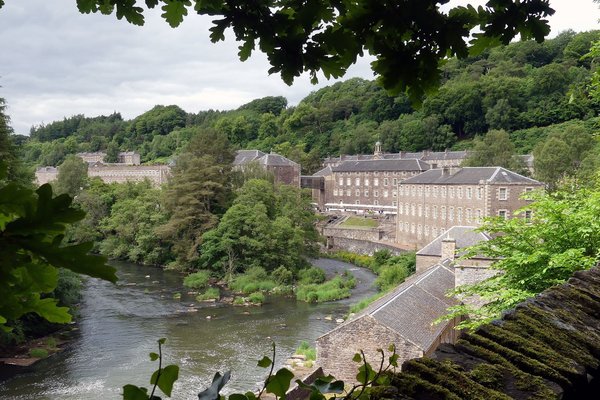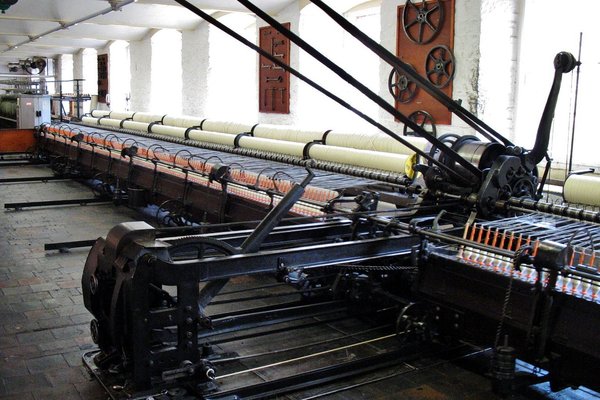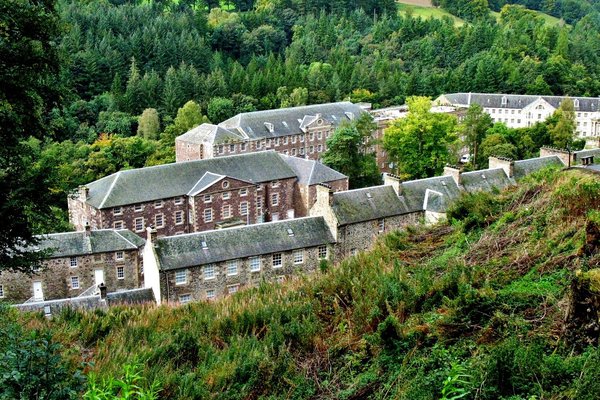United Kingdom
New Lanark
New Lanark was an innovative industrial community centered around textile production.
The community was the product of David Dale, the cotton mill owner who settled for this area to take advantage of the water power provided by the River Clyde, and his son-in-law, Robert Owen, a philanthropist and social reformer. New Lanark became a successful business and an epitome of utopian socialism, with specially designed workers' housing and public buildings.
Community Perspective: in a beautiful location, “but it does lack a coherent adult message”. A visit to Robert Owen's house is recommended. The official map is terrible, but we are confident of the core zone shown on our map below.
Site Info
Official Information
- Full Name
- New Lanark (ID: 429)
- Country
- United Kingdom
- Status
-
Inscribed 2001
Site history
History of New Lanark
- 2001: Inscribed
- Inscribed
- 1988: Deferred
- "until an overall view of the sites where social doctrines of the contemporary world evolved in connection with the industrial or agricultural revolutions had been realized and a comparative study on the industrial sites of 19th C had been carried out by ICOMOS"
- 1987: Deferred
- Crit vi (ideas) should be supported by additional ones
- Type
- Cultural
- Criteria
- ii
- iv
- vi
Links
- UNESCO
- whc.unesco.org
- Official
-
- newlanark.org — New Lanark World Heritage Site
- Related
-
- infed.org — Link
All Links
UNESCO.org
- whc.unesco.org — whc.unesco.org/
Official Website
- newlanark.org — New Lanark World Heritage Site
Related Resources
- infed.org — Link
News Article
- Oct. 21, 2024 archive.is — New Lanark in turmoil: mill closure, debts and controversy
- June 27, 2015 carlukegazette.co.uk — New Lanark’s £1.5 million grant
- June 6, 2010 scotsman.com — New Lanark attraction in line for £ 700,000 boost
- Oct. 21, 2009 bankingtimes.co.uk — New Scottish £ 20 notes enter circulation featuring Robert the Bruce one side, and the historic mill house New Lanark on the other
- Dec. 11, 2008 lanarkgazette.co.uk — New Lanark Village gets a half million pound Historic Scotland cash injection
Community Information
- Community Category
- Secular structure: Factories and industry
- Human activity: Urban planning
Travel Information
Edinburgh Hotspot
Recent Connections
-
Ten years or more to inscribe
1987 - 2001 -
Located in a TCC Territory
Scotland -
Hydro Power Stations
"The 250 yard tunnel was cut to lead th…
Connections of New Lanark
- Trivia
-
-
On Banknotes
Robert the Bruce and New Lanark - 20 pound - 2009
-
- Ecology
-
-
Otters
The WHS boundary includes a section of the River Clyde up to the weir
-
- Architecture
- World Heritage Process
-
-
Ten years or more to inscribe
1987 - 2001 -
Need for a Comparative Study
Industrial sites of 19th Century - TICCIH prepared a comparative study of "Workers' villages as elements of the industrial heritage," at the request of ICOMOS (submitted with nomination of Crespi d'Adda 7 years later)
-
- Human Activity
- Constructions
-
-
Tunnels
Built to provide a 35ft head of water to the water wheels (later to the turbines): "1785 and later....Submerged stone and timber weir...channelling water through rock-cut tunnel at SE end of New Lanark village about 250 yards long and 12 feet in diameter under the hillside and into the lade"..." -
Hydro Power Stations
"The 250 yard tunnel was cut to lead the water from the Clyde to the water wheels in each mill....-by the end of the 19th century water was driving a turbine to create electricity"... " The lade was restored in the 1980s and is still in use today, supplying water to the restored Boving turbine in the basement of Mill 3 which provides hydro-electricity" to the WHS. The Bonnington hydro power station fed from the Clyde was opened in 1927 as part of the "Lanark hydro electric scheme" but is situated in the buffer zone. -
Water wheels
Mill Number Four ... In 1990 a waterwheel was brought from Hole Mill Farm, Fife, and installed on the site of the mill. (wiki) - the ten original water wheels, which drove the mills, were gradually replaced by three water turbines
-
- WHS on Other Lists
- Timeline
-
-
Built in the 18th century
founded in 1786
-
- WHS Hotspots
-
-
Edinburgh Hotspot
34 miles from Edinburgh
-
News
- archive.is 10/21/2024
- New Lanark in turmoil: mill closur…
- carlukegazette.co.uk 06/27/2015
- New Lanark’s £1.5 million grant
- scotsman.com 06/06/2010
- New Lanark attraction in line for …
Recent Visitors
Visitors of New Lanark
- Adrian Turtschi
- ailsa
- Alberto Rodriguez Gutierrez
- Alexander Lehmann
- Alex Baranda
- Alex Goh
- alicemears
- A. Mehmet Haksever
- Anna Wludarska
- Argo
- Ask Gudmundsen
- Atila Ege
- BaziFettehenne
- Bill Maurmann
- Birgitte Sørensen
- Bram de Bruin
- Brendan Carroll
- ButterflyEarring
- CampbellME
- Can SARICA
- cc1967
- CeeMon
- Cezar Grozavu
- cflw
- Cheryl
- ChrisN
- Christer Sundberg
- Christoph
- Christravelblog
- Claire Bradshaw
- Clyde
- Cobaltrage
- Colossus
- Cristina Erba
- Damientournay
- Danny L
- Digits
- Dimitar Krastev
- Dimitrios Polychronopoulos
- Dirk-pieter
- Elaine McArdle
- Els Slots
- Erik Jelinek
- Errol Neo
- Eva Kisgyorgy
- Fan Yibo
- Farinelli
- Filip Murlak
- finsbury_jo
- Flexiear
- Frederik Dawson
- FS
- Gary Arndt
- Geert Luiken
- George Gdanski
- GeorgeIng61
- Gernot
- Harry Mitsidis
- Hubert
- Hurrvinek
- Iain Jackson
- Ian Cade
- Ilya Burlak
- Ivan Rucek
- Jacob Choi
- Jakob F.
- James Bowyer
- Janina Lehmann
- Jan-Willem
- Jasam
- Jawnbeary
- Jay T
- Jeanne OGrady
- Jesse S 2010
- Jezza
- Joel on the Road
- Jonas Hagung
- Jonas Kremer
- Karito Vies
- Klaus Freisinger
- Kyle Magnuson
- Lara Adler
- Laurine
- Lithobates
- Luis Filipe Gaspar
- Maciej Gil
- marcel staron
- Martina Rúčková
- Marty
- MH
- Mikko
- MMM
- nan
- Nasebaer
- Niall Sclater
- Nihal Ege
- PabloNorte
- Patrik
- Paul Schofield
- Peter Lööv
- Petri Jurescu
- Petteri
- Philipp Peterer
- puessergio
- Ralf Regele
- Randi Thomsen
- Rodinia
- Roger Ourset
- Roman Bruehwiler
- Rosemary
- Rudegirl
- Sabrina Liebehentschel
- Schnitzel
- SDMArado
- serghei.belous
- Sergio Arjona
- Shandos Cleaver
- Sijia
- SirLoydd
- Solivagant
- Squiffy
- Ssong.x
- Stanislaw Warwas
- Svein Elias
- Szucs Tamas
- Taotao Chen
- Tatiana Nikulnikova
- Thomas Buechler
- Thomas Harold Watson
- Tom Flaten
- triath
- Truls Brekke
- Tsunami
- usagi1974
- ValiaVeweth
- Van Hung
- Vincent Cheung
- V&M
- Wojciech Fedoruk
- Wo_ko
- wrung24
- YaroMir
- Yongcheng Liu
- Zach
- Zoë Sheng
- Александар Стојиљковић
Community Reviews
Show full reviews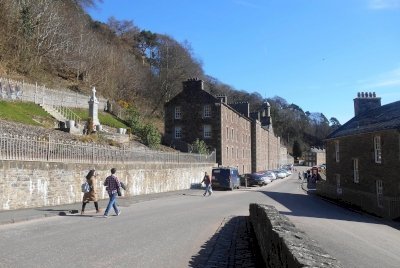
The easiest way to reach New Lanark is through the old Lanark, which apparently dates back to at least 1140 as a market town during the reign of King David I. Today, Lanark has a railway station that lies at the end of a spur off one of the many lines that link Glasgow and Edinburgh. There is a half-hourly service from Glasgow Central but, due to the layout of the track, no trains can travel down to Lanark from the east so travelling from Edinburgh requires a change at Motherwell as I did. Lanark is a pleasant enough town but there isn’t a great deal to do or see there so I walked through it quickly and made my way along the roads to New Lanark, which only took about 30 minutes to reach the outskirts of. The road down into New Lanark takes a long hairpin route to reach the valley of the River Clyde below but there are more direct footpaths through the woods for pedestrians such as myself. This was fine coming down but the shorter distance comes at the cost of a steeper incline on the way back up the hill. There is a small quiet graveyard in the woods here that might form part of the core zone but the maps on the UNESCO website, including in the original nomination file, were an incomprehensibly pixelated mess when I tried to access them.
Descending into the valley, there are the old mill buildings and …
Keep reading 0 comments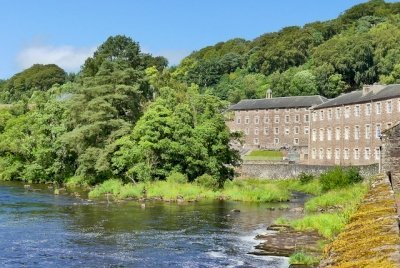
I visited this WHS in July 2019 as a very convenient stopover while driving from Lake District National Park towards Edinburgh. This WHS can be seen as one of a series of similar industrial sites in the UK, namely Derwent Valley Mills, Saltaire and New Lanark. All three WHS aren't wow destinations or top WHS but all offer an informative visit to how UK's industry and working conditions looked like during the last century or so.
Of the three I'd pick the Derwent Valley Mills as it is well presented and you can see some machinery still working. Even though my least favourite is Saltaire, New Lanark wasn't much better. At least there were a couple of information boards and I was surprised by the roof garden which was so ahead of its time. But apart from that, everything else was pretty much empty or geared mostly at school outings not WH travellers. The trail to the Falls of Clyde was pleasant enough mostly because I always had wanted to visit them (because of my name though!). If you're staying over in New Lanark during the peak months, you can also arrange a night walk at the visitor centre to spot the resident badgers.
There's a big free of charge visitor parking lot just before going down towards New Lanark and the panoramic view from there is worth having. However, after a couple of photos, you're better off walking back to your car and parking near the visitor …
Keep reading 0 comments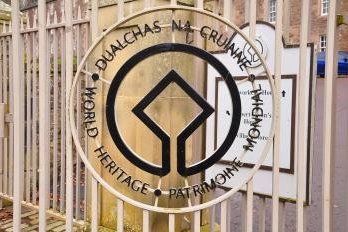
After I visited New Lanark initially, I had no desire to write the review since strangely most of my experience on this industrial village was similar to Tsunami’s recent review, while I agreed with most of the review, I think I should write at least something good from my visit to New Lanark.
Traveling to see UK’s World Heritage Sites mandatorily made me to visit at least 3 industrial villages, Saltaire, Derwent Valley and New Lanark, and in my opinion all of them are really poor in terms of presentation and managements. I did not have any nice memory to remember on Derwent Valley nor any word to praise on my visit to Saltaire, so I did not expect anything from my visit to New Lanark. And my low expectation kept me to be OK with this place where similar problem I saw in Saltaire and Derwent reoccurred again. But at least I felt the management on New Lanark is slightly better. The lovely location and beautiful natural surroundings also help a lot to make the visit worthwhile.
Contrast to Tsunami’s, I found its award-winning ice cream is really good and a must try if you visit this place especially the vanilla one. Its cafeteria was also quite OK if there is no noisy school trip and have shepherd’s pie. And I think this is the easiest place to see the emblem of UNESCO World Heritage Site that write in Scottish Gaelic - Dualchas na Cruinne.
Keep reading 0 comments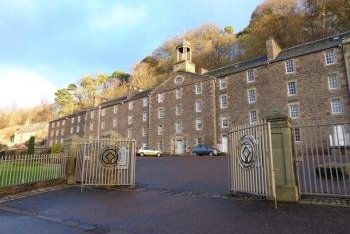
From Edinburgh I stopped at Lanark by train on my way to the Glasgow airport.
At the Lanark train / bus station on a Wednesday morning I asked a bus driver if there is a bus to New Lanark, and she suggested that I took a cab.
So I just walked to the New Lanark WHS.
I have to say I did not particularly like this site, not because I disagree with OUV or because I didn't find anything interesting, but because of some strange atmosphere.
First, what was that huge souvenir shop that looks like a supermarket and that sells things totally unrelated to the site??? (This shop may have opened recently.)
Second, I seriously felt that people who worked there were unusually unfriendly, beginning with the lady at the visitor center. I was about the only tourist when I got there at 9.30, and everybody avoided eye contact with me and said nothing to me as I walked around, as if they didn't want to start working that early in the morning. Are they so underpaid? The clerks at the supermarket were also unfriendly; they don't like tourists probably because when the dust settles after tourists leave, they have to clean the dust!
Third, after all this I did not even care for the ice cream they claimed they had created in order to fund their projects. It's probably the same ice cream I had at the Derwent Valley Mills WHS anyway!
I understand that these industrial heritage …
Keep reading 0 comments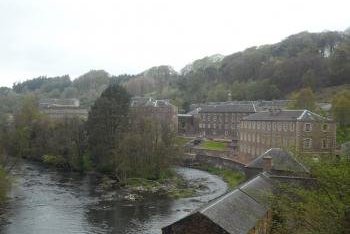
We visited New Lanark on drizzly day in April. I’m not sure if it’s necessarily the best sort of conditions to visit a very grey Scottish mill town, but never mind.
The best view of New Lanark is also normally your first.
As you come down the hill from the car park, you are presented with a nice little panoramic view of the entire site. Consisting of four mill buildings, several terraced housing units and a scattering of extra buildings such as a school, engine house and a church, the site is nestles tightly along a bend in the River Clyde, surrounded on all sides by wooded hills. It feels quite intimate, and has peculiarly picturesque quality to it.
The visitor centre does a good job in explaining the background of the site. However, the presentation is very modern, and doesn’t feel very in keeping with the setting. Most egregious is the weird tram-like gondolas that take through the story of one of the historical residents. I guess it’s meant for children, but I’m not sure whether they would find it engaging or not. Other slightly dubious choices include a large glass and steel bridge connecting two of the mill buildings, and an out of place (though none the less pleasant) roof garden.
The rest of the site is fine. We completed the tour, looked around the fairly standard gift shop, and spent a pleasant few hours doing some of the riverside walks (not technically part of the heritage site, …
Keep reading 0 comments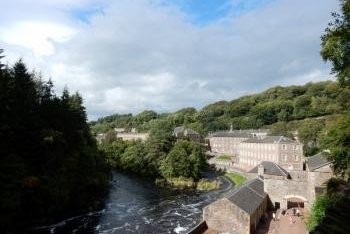
This is really quite an interesting site because of its good state of preservation - you can easily imagine yourself being a millworker (or owner) in the early 19th century. The museum/visitor centre is a bit on the touristy side (telling the sad story of poor Annie McLeod who had to work in the cotton mills at an early age), but all buildings are well-preserved, including the schoolhouse and the residence of founder Robert Owen. You learn a lot about his ideas of utopian socialism, worker welfare, and urban planning (including his attempts to recreate a similar site in New Harmony, Indiana). The cotton mills were powered by the River Clyde which runs through the village, and you can walk upstream through a nature reserve to the famous Falls of Clyde. New Lanark is quite easily reachable by bus from the larger town of Lanark, which has direct rail connections to Glasgow.
Keep reading 0 comments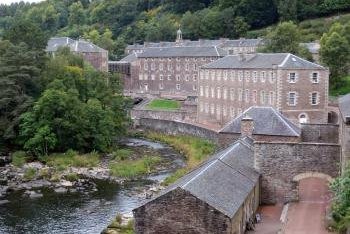
I went to New Lanark expecting to see a mill town similar to those I'd seen in the eastern United States, and I was not disappointed when I visited in fall 2015. Like other historical towns I've toured, this site is very well organized to educate school groups; that is probably fitting, since the education of children is one of the key components of the vision of Robert Owen, the social reformer who founded New Lanark. Owen created a society at the mill in which workers had good housing for their families, and their children had education through Britain's first infants' school. Owen hoped that not only would his mill town turn a profit, but that the lives of his workers would improve. Even though I've seen similar towns in the United States, I enjoyed walking through the factory, school, and museums at New Lanark and learning more about Owen's vision. I also appreciated the walk up the Clyde River to the very scenic Falls of Clyde.
Logistics: New Lanark is easiest to reach by automobile, and is only a short drive away from both Glasgow and Edinburgh.
Keep reading 0 comments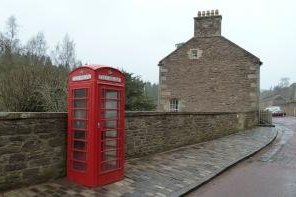
A mixture of work and the chance to see my cousin DJ in Glasgow gave me an opportunity to open my WHS account for 2013. A great weekend mixed with lowered expectations actually made this a rather rewarding visit.
Having looked at maps before my visit I had always seen the town’s layout as a little odd, but upon reaching the crest of the valley in which it sits it all suddenly made sense. It is actually quite a picturesque setting, sitting as it does in a valley carved out by the Clyde. The river forms Britain’s largest waterfalls just downstream from the town and at this point the water is fast flowing which was the key factor in the building of the mill here.
Several people I had spoken to in Glasgow before my visit had all visited New Lanark on school trips as kids and (like Els and Kyle) I did feel that the majority of the visiting experience was aimed at the local school children. Having said that the ‘futuristic hanging fairground ride’ was fairly engaging and did decent job of introducing basic concepts about life in the Mill. It can be rather tough to find uses for these large ex industrial buildings and presence of an ‘Edinburgh Woollen Mill’ outlet showed that it was a challenge that had not been tackled too well here. A visit to the former school was reasonably interesting, though I would say it would perhaps be best to skip the well-intentioned …
Keep reading 0 comments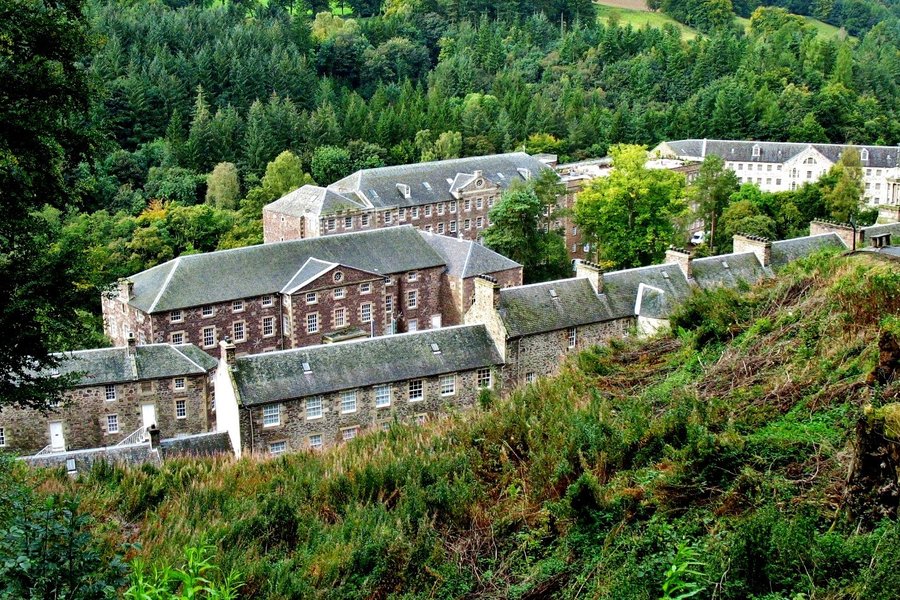
Somewhat of a mystery for me when I visited in 2007, New Lanark's OUV only revealed itself years later. Clearly important in relation to Owens Socialist ideas and philosophy concerning Industrial Britain. New Lanark needs a little sprucing up in its tourism appeal (circa 2007). It is indeed a fascinating site, located in a beautiful location in southern Scotland, but it it seemed to lack a coherent adult message. New Lanark tourism is somewhat strange in its attempt to entertain children, yet during the tour I felt amongst the tacky aspects, it lacked a clear message on the importance of New Lanark and what Owens was really trying to create. Moreover, a basic understanding of Enlightenment Ideals, early industrial technology, 'ideal city' concepts, and the garden city movement all help the visitor place New Lanark as a worthy WHS. For me personally, New Lanark was one my first ten world heritage sites, I was half-way through College, and thus my familiarity with the heritage values on display were limited.
The closest equivalent WHS I've since visited is Moravian Bethlehem in Pennsylvania. While quiet different, its industrial values and concept of an “ideal city” paired with Enlightenment ideals make an interesting comparison. I suppose I would appreciate New Lanark more today than I did at the time.
Keep reading 0 comments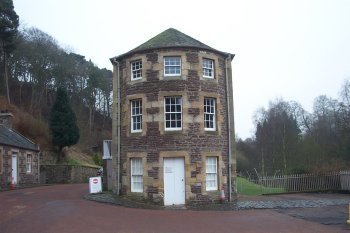
On this Sunday morning, I took a train from Glasgow to Lanark, a direct connection taking 55 minutes. At the rather desolate Lanark station, there was a bus waiting that took me to the New Lanark WHS within a few minutes. Measured by the huge car park, this is a very popular place for summer outings.
This site's greatest asset is its really lovely setting, near the river that supplied the necessary power for making the mills work. A good place to develop into Utopia! The buildings in this tiny village are well restored, and some of the houses even are in use as modern apartments. You can have a look inside several houses, the mills, the school, and a shop. All in all, it's a nice place to walk around for an hour or two.
On the minus side, I didn't find the exhibitions too great. There's a lot to see and do for children, but not so much for people over 12.
Like some of the Derwent Valley Mills (another UK WHS, related to this one and very much alike in ambiance) some of the buildings are used for uninteresting shops. And why this strange award gallery that you have to pass through?
Keep reading 0 comments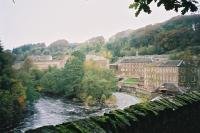
After having visited the Giants Causeway on Northern Ireland I continued down to Belfast to catch the fast-ferry over to Scotland. I apologise sincerely to all Belfastians but I was not very impressed by the city so I decided to wait for my boat in the harbour for a couple of hours. This was certainly not the most exquisite area of the town but when standing there, I found myself overlooking a shipyard on the other side of the harbour, a wharf named Harland & Wolff and suddenly I realised that this was the site where once the magnificent Titanic was built, back in 1911-12…wow, historic grounds…!
When I later boarded the ferry that was going to take me across the Irish Sea it turned out to be something along the lines of Titanic's grandeur -
the worlds largest catamaran, a 160 meter long ship with a top speed of over 40 knots that would have envied the 1911 shipbuilders in Harland & Wolff if they would have had the opportunity to experience this amazing ship of the 21st century.
Arriving Glasgow late in the evening, I decided to withdraw to my hotel room and save my energy for my visit to the cotton mill New Lanark on the following morning. For those not as exhausted by travelling as I was at this point, Glasgow provides you with a very good nightlife and numerous nice bars. Pubs and clubs are just waiting to cater for European party-connoisseurs that come up …
Keep reading 0 comments
